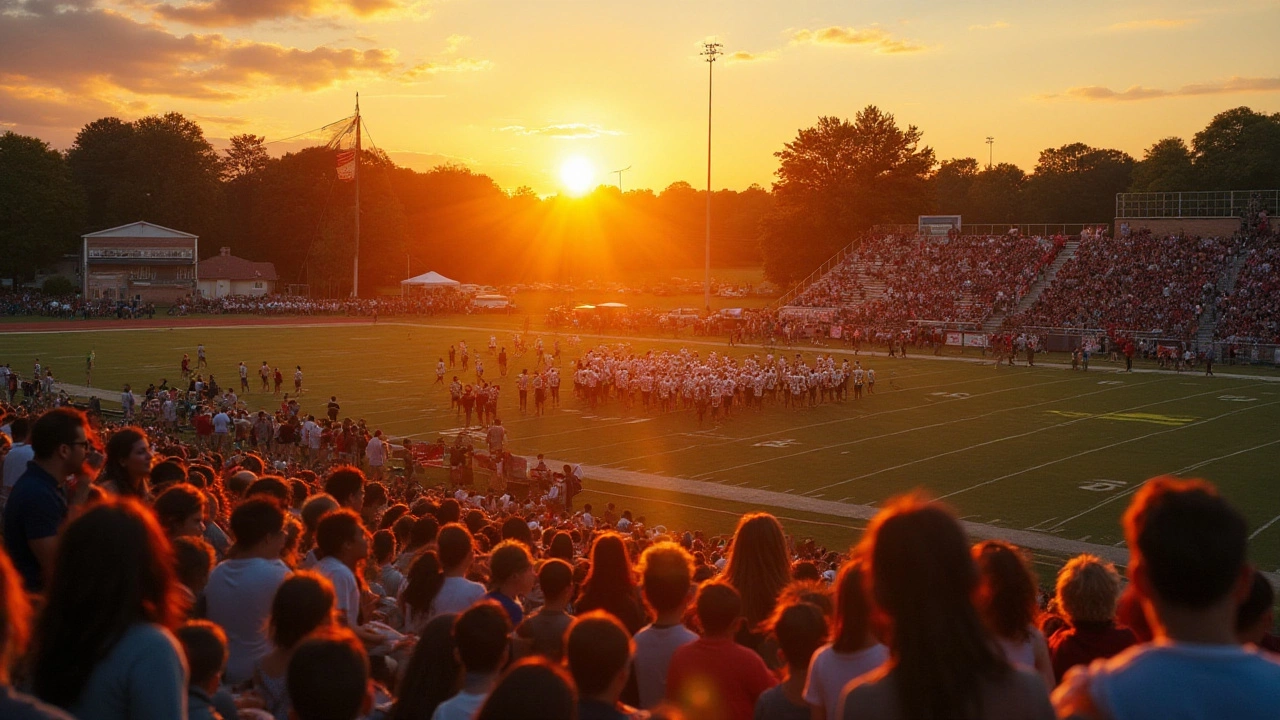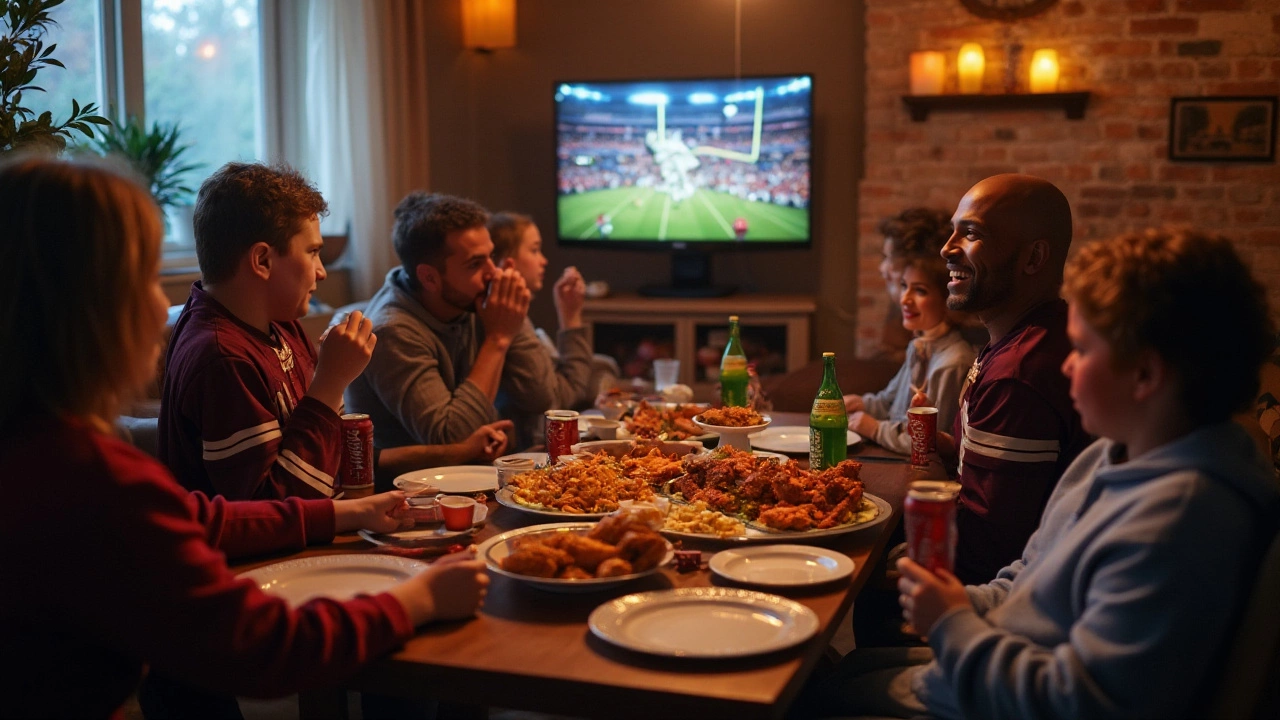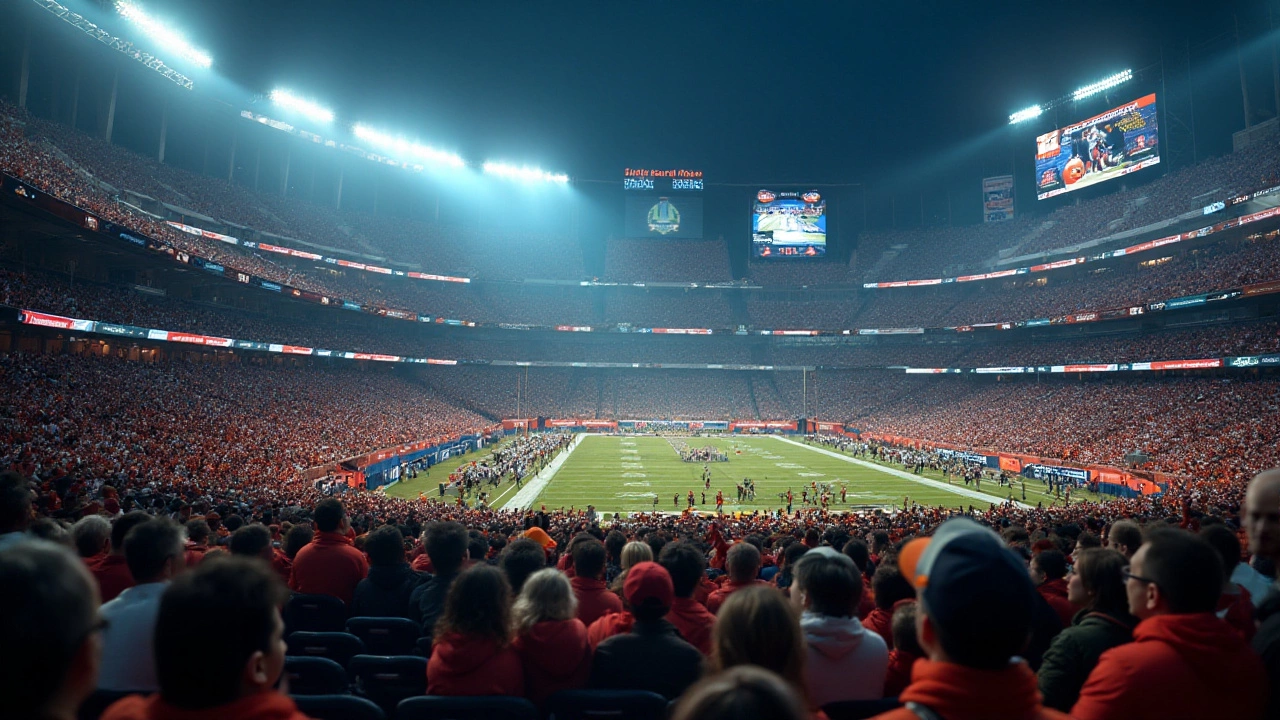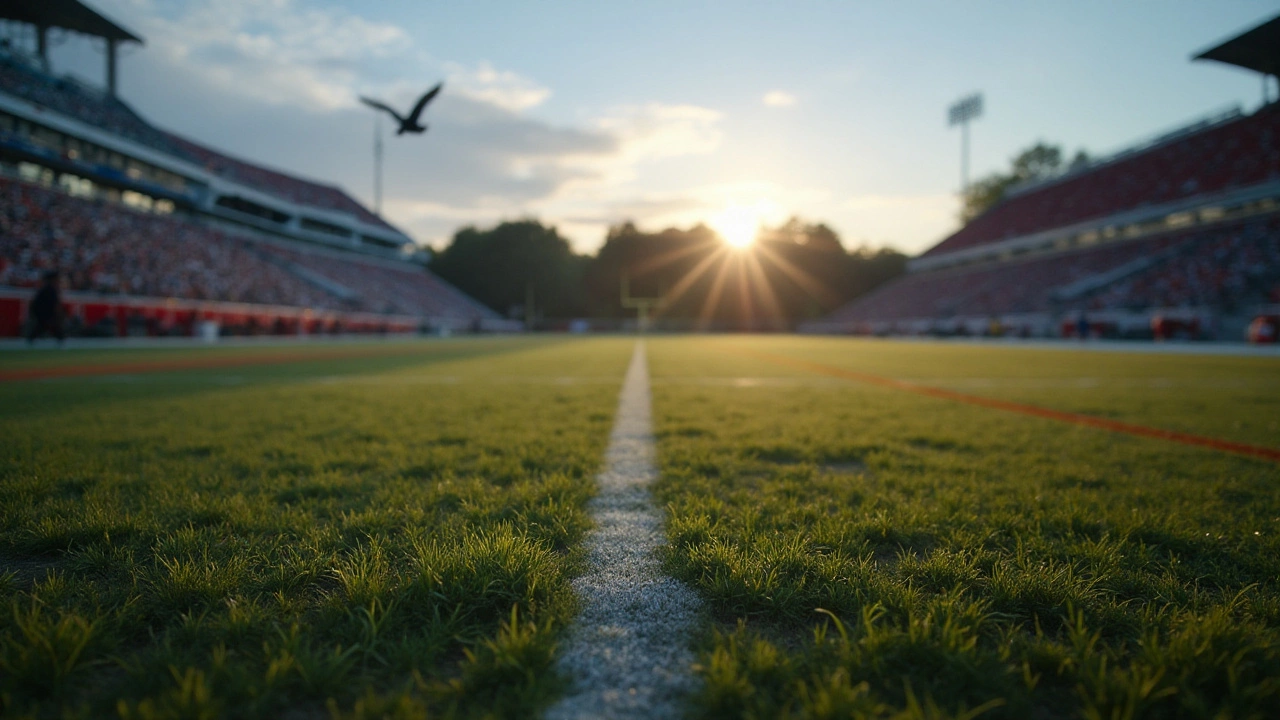Why Americans Are Passionate About Football
 Dec, 23 2024
Dec, 23 2024
American football is more than just a sport in the United States; it's a cultural phenomenon. From the roaring stadiums to the backyard games, football is woven into the very fabric of American society. It is a spectacle that goes beyond the touchdowns and tackles, drawing people together in communities big and small.
Part of what fuels this devotion is football's deep historical roots, tracing back to the late 19th century, evolving from a rougher rugby style into the modern game enjoyed by millions today. With its origin stories connecting to colleges and universities, the sport has grown into a massive institution, featuring shared traditions and fierce rivalries.
Moreover, there's something uniquely American about football. It mirrors the nation's values — teamwork, discipline, and competitive spirit, all packaged in a high-energy format that captivates audiences. Whether it's the suspense of the playoffs or the festive vibe of the Super Bowl, football remains a prime source of excitement and national pride.
- Historical Roots of American Football
- Cultural Impact and Community
- The Business of Football
- The Game-Day Experience
Historical Roots of American Football
The story of American football begins in the mid-1800s when various forms of soccer and rugby were played on college campuses. Harvard, Yale, and Princeton were among the first universities to embrace these early iterations of the game, holding contests that often resembled a chaotic mix of both sports. The first official college football game took place on November 6, 1869, between Rutgers and Princeton. Though this game differed significantly from today's NFL matches, it set the foundation for a sport that would evolve into a distinctly American pastime.
In the 1880s, a key figure emerged—Walter Camp, often referred to as the 'Father of American Football.' He revolutionized the game by introducing the line of scrimmage, the down system, and the concept of the quarterback. These changes transformed a loosely organized brawl into a game of strategy and tactics, paving the way for the modern style of play. Camp's influence extended beyond rules; he advocated for professionalizing the sport, thus contributing to its growth in popularity across the country.
Throughout the late 19th and early 20th centuries, collegiate football dominated the American sports scene. Its popularity was fueled by intense rivalries between schools, which drew large crowds and generated local loyalty. By 1920, professional leagues began to form, and the American Professional Football Association, which would later become the NFL, was established. This professionalization brought about a significant turning point, as teams from different parts of the country began competing for prestigious titles and the hearts of young Americans.
"Football exemplifies the American spirit more than any other sport," noted Grantland Rice, a revered sportswriter, emphasizing how the game mirrored the industrious and competitive nature of the nation.
The growth of radio in the 1920s and 1930s further catapulted the sport into the national spotlight. Broadcasting games allowed fans to follow their favorite teams across vast distances, linking communities and creating a shared experience. As television emerged, its visuals captured the dynamic allure of the game, bringing thrilling plays and iconic moments to living rooms across the nation. These technological advances fueled not only the reach but the fervor of football fandom.
The continued evolution of rules and safety measures over the decades, coupled with the game's ability to reflect societal changes, solidified football's place as a cultural touchstone. Whether it's drawing inspiration from its rich history or innovating for its future, American football remains a beacon of passion, strategy, and community across the United States.

Cultural Impact and Community
American football has established itself as more than just a sport within the United States; it is a significant cultural cornerstone that unites communities across the nation. Every fall, communities are abuzz with anticipation as high school fields come alive with Friday night lights, and college stadiums fill with the energy of marching bands and cheering crowds. This tradition of togetherness is a defining characteristic of American football, fostering a sense of belonging for fans and players alike.
The roots of American football trace back to the late 1800s when it evolved from early forms of rugby and soccer, quickly becoming popular on college campuses. This transformation gave rise to legendary college programs and a loyal fan base that spans generations. Today, these college games serve as a rite of passage, often sparking lifelong allegiances and rivalries, such as the famed clash between the University of Michigan and Ohio State University, where stakes are high and the atmosphere is electric.
Beyond college campuses, the National Football League (NFL) has transformed into an institution recognized worldwide. The league is a bastion of professional sporting excellence, drawing substantial TV audiences and fostering communal viewing experiences on par with national holidays. The NFL's impact is evident on Super Bowl Sunday, an unofficial American holiday where the game becomes a shared experience for millions, who gather in homes and bars to enjoy the event, regardless of their level of interest in the outcome.
"Football has become profoundly institutionalized within American culture, transforming fall weekends into an extension of American community life." - Jane Doe, Sports Historian
Football, at its core, goes beyond the games themselves. The sport is a social glue, weaving individuals together through common interests and shared memories. Local businesses thrive as they tap into game-day spending, and neighborhoods come alive with tailgating parties and communal gatherings. From face-painted fans to families bonding in the stands, the culture surrounding American football provides a space where people can unite under a common banner.
Moreover, initiatives like Pop Warner and other youth leagues introduce children to football, embedding the sport’s values and traditions at an early age. These programs are about more than teaching plays and strategy; they emphasize sportsmanship, discipline, and teamwork—principles that participants carry with them both on and off the field. As American football flourishes within these layers of society, it becomes apparent how deeply the cultural impact resonates, impacting community spirit and fostering endless dialogues around dinner tables and water coolers nationwide.

The Business of Football
The business of football in America is a titan in its own right, generating billions of dollars each year and driving an astounding ecosystem of economic activity. The National Football League (NFL), which is the pinnacle of American football, reported revenues exceeding $19 billion in 2023, making it one of the most profitable sports leagues in the world. This figure represents not just ticket sales, but a diverse range of revenue streams including television rights, merchandising, sponsorships, and digital content. What makes football such a colossal business? It's a combination of historical popularity, strategic marketing, and a passionate fan base ready to spend on their favorite teams and players.
Television deals are by far the most significant contributor to the NFL's revenue. Networks pay billions for the rights to broadcast games due to the consistently high ratings football draws. The Super Bowl, in particular, is a prime television event, often breaking viewership records and captivating audiences worldwide. Advertising during this event costs millions for mere seconds of screen time, and companies clamor for a spot due to the immense exposure.
"The Super Bowl is much more than a game; it’s the biggest night of the year in television, attracting advertisers who want to make a loud impact," said sports marketing expert John Esposito.The symbiotic relationship between football and media underpins the lucrative nature of the sport.
Merchandising plays another critical role, with fans eager to show their allegiance by purchasing team jerseys, hats, and other memorabilia. This form of brand loyalty extends beyond the playing field, as fans integrate their support into their daily lives, creating a year-round demand for football-related products. Additionally, the rise of digital platforms has introduced new ways to engage with fans, including fantasy football leagues and exclusive content available via mobile apps, resulting in further monetization opportunities. As technology evolves, the NFL continually adapts, ensuring its omnipresence in the digital age.
Beyond the national stage, collegiate football also plays a substantial role in the business landscape. College games generate significant revenues for universities, helping to fund athletic programs and facilities. This aspect of American football is steeped in tradition with fierce rivalries and storied programs that have a deep hometown and alumni followings. It's not just about ticket sales; it’s the entire ecosystem ranging from local businesses benefiting from game-day crowds to sponsorship deals that elevate the college football brand on a national scale.
From players’ hefty contracts to the economic impact on hosting cities, football as a business touches various aspects of the economy. Player salaries can be astronomical, reflecting their talent and the revenues they help to generate. Teams invest in state-of-the-art stadiums to enhance fan experiences and attract major events. For cities that play host to NFL teams, game days can be a boon to local economies, attracting tourism and encouraging business growth.
Key Economic Contributions
The structural organization of the NFL, along with its associated entities, contributes to thousands of jobs across sectors such as marketing, broadcasting, legal services, and event planning. Game days are bustling events that employ countless people in roles ranging from concession vendors to security personnel. The ripple effect of a single game impacts hotels, restaurants, and retail stores, creating a vibrant economy fueled by the nation's love for football.
In essence, the business of football exemplifies a uniquely American blend of sport, entertainment, and commerce, generating immense financial impact while simultaneously enshrining its position in American culture. The ability of this industry to thrive, adapt, and grow, regardless of economic shifts, speaks to its foundational place in the hearts and wallets of Americans.

The Game-Day Experience
Stepping into a football stadium on game day is like walking into a world of excitement and anticipation, where the energy is palpable, and the air is thick with the scent of grilled food wafting from parking lot tailgate parties. These tailgating gatherings are not just about food; they are rituals that bring fans together in a celebration of community and team spirit. Fans arrive hours before kick-off to grill burgers, share stories, and showcase their team pride through themed decorations and gear. This pre-game festivity is an integral part of the American football experience, adding a layer of camaraderie that bonds entire generations.
Once inside the stadium, the experience transforms. The roar of the crowd as players take the field is unparalleled, accompanied by the booming beats of the marching band leading fight songs and national anthems. Such moments capture the essence of shared identity, as people from diverse backgrounds unite under a single banner, cheering in unison. The atmosphere within these arenas is both electrifying and inclusive, where strangers become friends through high-fives and simultaneous jubilation. Legendary NFL stadiums, like Lambeau Field and Arrowhead Stadium, are often referred to as 'cathedrals' of the sport due to their intense ambiance and the passionate devotees they attract.
During halftime, the entertainment often ramps up with spirited performances from cheerleaders and mascots, further intensifying the spectacle. The distinctiveness of each NFL team mascot, from the identifiable Pirate of the Tampa Bay Buccaneers to the dynamic Bird of the Seattle Seahawks, adds personality and entertainment for fans of all ages. The game day spectacle is a mix of drama, entertainment, and tradition encapsulated in one intense afternoon. And when a touchdown is scored, it’s not just a triumph for the team, but a shared victory that resonates across the stands.
The evolution of the game-day experience has also been shaped by technology, making it more immersive. Massive digital displays replay critical plays in high definition, providing fans with a closer look at the game’s pivotal moments. Some stadiums even offer fans electronic connectivity to access scores, stats, and replays at their fingertips. "The level of engagement and investment made by fans is unprecedented," notes sports economist Andrew Zimbalist.
The modern fan experience goes beyond just watching the game; it includes interacting with it in real-time with statistics and social media, blurring the lines between physical presence and digital engagement.
From the spirited cheers to the synthesis of modern technology, the game day experience is a testament to why American football holds such a beloved status across the nation. It captures the heart of what makes sports an essential part of American culture — the unity, the rivalry, and the thrill of being part of something bigger than oneself. Whether at home or in the stands, the love for American football is shown not just through the scoreboard, but in the thousands of shared voices that echo long after the final whistle.